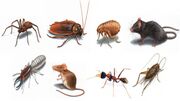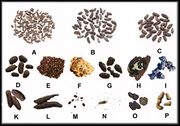Difference between revisions of "Pest"
Jump to navigation
Jump to search
| (3 intermediate revisions by the same user not shown) | |||
| Line 2: | Line 2: | ||
== Description == | == Description == | ||
[[File:Pest-control-image-1.jpg|thumb|Household Pests<br> from Livinator at [https://livinator.com/6-household-pests-and-how-to-get-rid-of-them/ Pests]]] | [[File:Pest-control-image-1.jpg|thumb|Household Pests<br> from Livinator at [https://livinator.com/6-household-pests-and-how-to-get-rid-of-them/ Pests]]] | ||
| − | Any unwanted [[insect|insects]] or animal, such as [[bird|birds]], [[bat|bats]], [[rodent|rodents]] that causes damage or makes itself a nuisance. Pest damage can include material loss (holes, tunnels, chewed wires, etc), fouling ([[fly speck|flyspecks]], [[guano|guano]], etc.). [[Integrated%20Pest%20Management|Integrated Pest Management]] programs are instituted to minimize damage by pests. Chemical [[Pesticide|pesticides]] have been used since the 18th century to destroy pests | + | Any unwanted [[insect|insects]] or animal, such as [[bird|birds]], [[bat|bats]], [[rodent|rodents]] that causes damage or makes itself a nuisance. Pest damage can include material loss (holes, tunnels, chewed wires, etc), and fouling ([[fly speck|flyspecks]], [[guano|guano]], etc.) or human injury/illness. [[Integrated%20Pest%20Management|Integrated Pest Management]] programs are instituted to minimize damage by pests. These methods primary modify the habitats to minize food sources and protect sensitive items. Additionally, pest infestations can be treated with traps, freezing, heating, and anoxic environments. |
| − | [[File:Pest-poop-identification-chart-differences.jpg|thumb|Pest droppings Chart<br> From [https://www.abeepestpro.com/differences-types-of-pest-droppings-poop.htm | + | |
| + | Chemical [[Pesticide|pesticides]] have been used since the 18th century to destroy pests. As many pesticides are also toxic to humans and leave residues, their use has diminished. | ||
| + | [[File:Pest-poop-identification-chart-differences.jpg|thumb|Pest droppings Chart<br> From [https://www.abeepestpro.com/differences-types-of-pest-droppings-poop.htm A Bee Pest Pro]]] | ||
==Resources and Citations== | ==Resources and Citations== | ||
* MuseumPest.net at [https://museumpests.net/ Link] | * MuseumPest.net at [https://museumpests.net/ Link] | ||
* ''Encyclopedia Britannica'', http://www.britannica.com Comment: "pest." Accessed 15 Feb. 2005. | * ''Encyclopedia Britannica'', http://www.britannica.com Comment: "pest." Accessed 15 Feb. 2005. | ||
* David Pinniger, ''Pest Management in Museums, Archives and Historic Houses'', Archetype Publications, London, 2001 | * David Pinniger, ''Pest Management in Museums, Archives and Historic Houses'', Archetype Publications, London, 2001 | ||
| − | * Wikipedia: [https://en.wikipedia.org/wiki/Pest_(organism) Pest | + | * Wikipedia: [https://en.wikipedia.org/wiki/Pest_(organism) Pest (organism)] |
[[Category:Materials database]] | [[Category:Materials database]] | ||
Latest revision as of 10:00, 4 August 2023
Description
Any unwanted insects or animal, such as birds, bats, rodents that causes damage or makes itself a nuisance. Pest damage can include material loss (holes, tunnels, chewed wires, etc), and fouling (flyspecks, Guano, etc.) or human injury/illness. Integrated Pest Management programs are instituted to minimize damage by pests. These methods primary modify the habitats to minize food sources and protect sensitive items. Additionally, pest infestations can be treated with traps, freezing, heating, and anoxic environments.
Chemical pesticides have been used since the 18th century to destroy pests. As many pesticides are also toxic to humans and leave residues, their use has diminished.
Resources and Citations
- MuseumPest.net at Link
- Encyclopedia Britannica, http://www.britannica.com Comment: "pest." Accessed 15 Feb. 2005.
- David Pinniger, Pest Management in Museums, Archives and Historic Houses, Archetype Publications, London, 2001
- Wikipedia: Pest (organism)


